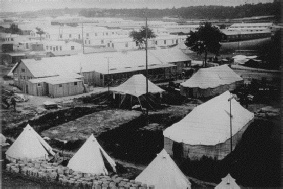Leyton & Leytonstone
Historical Society


First World War stories from St Mary’s Leyton churchyard
Albert Edward Austin (1895-1918) continued


Etaples was the main transit camp for the British Expeditionary force in northern France. It was also the point to which wounded soldiers for repatriation were transported, ambulance trains had arrived constantly from the Somme battlefield. There were 24 hospitals within the camp and a mysterious respiratory illness was noted in the camp during the winter of 1915-1916. There were overcrowded conditions all over the western front and in the camp at Etaples 100,000 soldiers were accommodated in tents or temporary wooden barracks, ideal for the spread of a respiratory virus. The camp had an extensive piggery and soldiers could buy live geese, chickens and ducks from nearby villages (there was a large goose farm virtually next door).
All this provided perfect conditions for cross species transfer of avian influenza A H1N1 virus into humans. A total of two million soldiers were camped in the surrounding area of Northern France, and six million soldiers occupied stretches of the 10 mile wide trench system from the English Channel to Switzerland. The circumstances of the conjunction of large numbers of soldiers, battle stress, chemicals affecting respiratory functions, pigs, ducks, geese (and horses) in Northern France may have led to the emergence of the virulent and rapidly fatal “Spanish” flu. Global spread resulted inevitably from the return home of troops after November 1918. However one of the counter arguments to this theory is that if flu emerged in this area in 1915 it should have caused a pandemic before 1918.